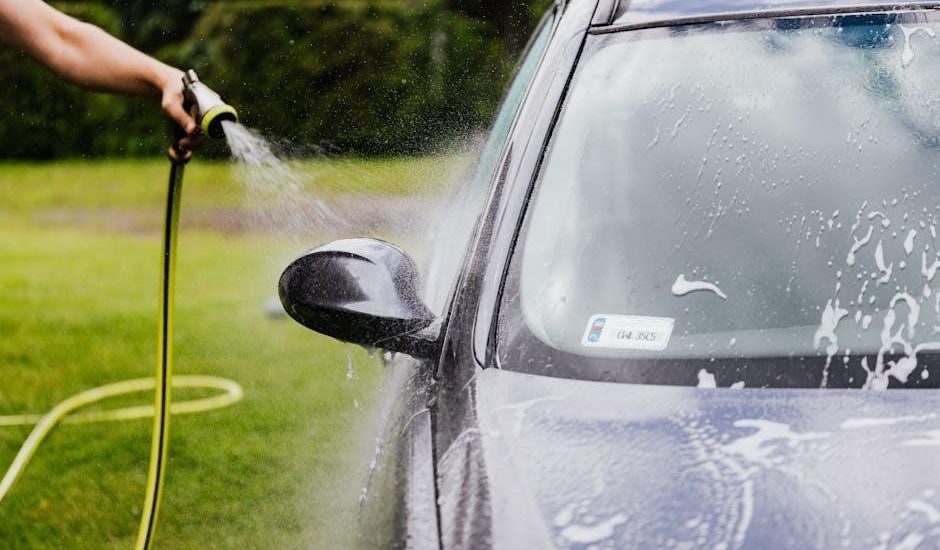Cub Cadet service manuals provide comprehensive guides for maintaining and repairing lawn tractors and utility vehicles. These manuals ensure safe, efficient, and proper equipment operation and care.
1.1 Overview of Cub Cadet Service Manuals
Cub Cadet service manuals are detailed guides designed to help users maintain, repair, and operate their equipment effectively. These manuals cover a wide range of topics, including routine maintenance, troubleshooting, and advanced repair procedures. They are tailored to specific models, ensuring accuracy and relevance for both DIY enthusiasts and professional technicians. The manuals often include diagrams, torque specifications, and parts lists, making them indispensable for anyone working on Cub Cadet tractors or utility vehicles. Whether you’re addressing common issues or performing complex overhauls, the manuals provide step-by-step instructions to ensure safety and efficiency. They are available in PDF format for easy access and reference, making them a vital resource for Cub Cadet owners seeking to maximize their equipment’s performance and longevity.
1.2 History of Cub Cadet Tractors
Cub Cadet tractors have a rich history dating back to 1961 when the brand was established by International Harvester Corporation. Initially known for producing compact, versatile tractors with engines ranging from 7 to 12 horsepower, Cub Cadet quickly gained popularity among homeowners and small-scale farmers. In 1981, the brand was acquired by MTD Products, a leading manufacturer of outdoor power equipment, which further expanded its product line and innovation. Over the years, Cub Cadet has become synonymous with durability and reliability, offering a wide range of lawn tractors, zero-turn mowers, and utility vehicles. The brand’s commitment to quality and customer satisfaction has solidified its position as a trusted name in the outdoor power equipment industry, with a legacy spanning over six decades.
1.3 Purpose of the Service Manual
The Cub Cadet service manual is designed to provide users with detailed instructions for maintaining, troubleshooting, and repairing their equipment. It serves as a comprehensive guide, ensuring owners can perform tasks safely and effectively. The manual includes maintenance schedules, diagnostic procedures, and repair techniques, helping users identify and resolve issues promptly. It also covers essential safety precautions, technical specifications, and parts diagrams to facilitate accurate repairs. Whether for routine upkeep or complex fixes, the service manual empowers users to maintain their Cub Cadet equipment in optimal condition, extending its lifespan and performance. This resource is invaluable for both DIY enthusiasts and professional technicians, ensuring proper care and operation of Cub Cadet tractors and mowers.

Safety Precautions and Guidelines
Safety is critical when working with Cub Cadet equipment. Always stop the engine, wear protective gear, and follow guidelines to avoid accidents. Ensure proper precautions are taken.
2.1 General Safety Tips for Maintenance
When performing maintenance on your Cub Cadet equipment, always ensure the machine is turned off and the key is removed. This prevents accidental start-ups. Disconnect the battery to avoid electrical shocks. Wear appropriate personal protective equipment, such as gloves and safety glasses, to protect yourself from potential hazards. Ensure the work area is clear of clutter and well-ventilated. Never work on the machine while under the influence of alcohol or drugs. Keep loose clothing and long hair tied back to avoid entanglement with moving parts. Follow all safety guidelines outlined in the service manual to ensure your safety during repairs and maintenance. Regularly inspect tools and equipment for damage or wear. Always refer to the service manual for specific safety precautions related to your model.
2.2 Personal Protective Equipment (PPE) Requirements
When working on your Cub Cadet equipment, wearing the correct personal protective equipment (PPE) is essential to ensure safety. Always wear safety glasses or goggles to protect your eyes from debris or chemicals. Gloves are necessary to prevent cuts, abrasions, and burns when handling sharp or hot components. A dust mask or respirator should be used when working with dusty or chemical-laden environments. Steel-toe boots or sturdy footwear can prevent injuries from heavy objects or tools. Long sleeves and pants can protect skin from scrapes and spills. Tie back long hair and avoid loose jewelry to prevent entanglement with moving parts. Ensure all PPE is in good condition and suitable for the task at hand. Refer to the service manual for specific PPE recommendations for your model and maintenance tasks.
2.3 Safety Best Practices
Adhering to safety best practices is crucial when maintaining or repairing your Cub Cadet equipment. Always ensure the machine is on a level surface with the parking brake engaged and the ignition turned off before starting any work. Disconnect the battery or spark plug wire to prevent accidental start-ups. Use jack stands for added stability when lifting the tractor. Keep loose clothing and long hair tied back to avoid entanglement with moving parts. Never smoke or use open flames near flammable materials like fuel or hydraulic fluid. Ensure good ventilation when working with chemicals or in enclosed spaces. Follow the manufacturer’s instructions for all tools and equipment. Regularly inspect tools and equipment for damage or wear. Keep children and pets away from the work area to minimize distractions and potential hazards. Make sure all safety decals on the equipment are legible and in place. Familiarize yourself with the equipment’s specific safety features before beginning any maintenance or repair tasks. Always refer to the service manual for model-specific safety guidelines and precautions. By following these best practices, you can significantly reduce the risk of accidents and ensure a safe working environment. Remember, safety should always be your top priority when working with machinery.

Maintenance and Repair Procedures
Routine checks, seasonal tips, and DIY repair guidelines ensure optimal performance. Follow the manual for oil changes, blade sharpening, and hydraulic system maintenance to extend equipment life.
3.1 Routine Maintenance Schedule
A well-structured routine maintenance schedule is essential for prolonging the life of your Cub Cadet equipment. The service manual outlines specific tasks to be performed at regular intervals, such as oil changes, filter replacements, and tire pressure checks. It also emphasizes the importance of inspecting belts, hoses, and other wear-and-tear components to prevent unexpected breakdowns. By adhering to this schedule, users can ensure their tractor or mower operates efficiently and safely. Regular maintenance not only prevents costly repairs but also enhances performance and reliability. Always refer to the manual for detailed instructions tailored to your model to maintain optimal functionality.
3.2 Seasonal Maintenance Tips
Seasonal maintenance is crucial for optimizing your Cub Cadet equipment’s performance throughout the year. During winter, drain fuel, change antifreeze, and store the mower in a dry, protected area. In spring, inspect and sharpen blades, check tire pressure, and ensure all fluids are fresh. Summer maintenance focuses on cooling system checks and cleaning debris from mowing decks. Fall preparation includes lubricating moving parts and preparing for storage. The service manual provides detailed seasonal checklists to ensure your equipment remains in top condition. By following these tips, you can extend the lifespan of your Cub Cadet and maintain its efficiency across all seasons.
3.3 DIY Maintenance and Repair
DIY maintenance and repair can save time and money while keeping your Cub Cadet equipment in optimal condition. Start by referencing the service manual for specific instructions tailored to your model. Regular tasks like oil changes, blade sharpening, and air filter replacements are straightforward and essential. For belt replacements, ensure proper tension to avoid wear. Use genuine Cub Cadet parts for reliability. Always disconnect the battery before starting repairs and follow safety guidelines. For complex issues, consider consulting the manual or seeking professional help. DIY maintenance fosters familiarity with your equipment and extends its lifespan when done correctly;

Troubleshooting Common Issues
Cub Cadet service manuals help identify and resolve common problems like faulty coils, worn belts, or hydrostatic transmission issues. Use diagnostic tools and the manual for quick solutions.
4.1 Identifying Common Problems
Cub Cadet service manuals detail common issues like worn mower belts, faulty coils, and hydrostatic transmission problems. These manuals help users diagnose issues efficiently. For instance, if a mower belt burns out frequently, the manual suggests inspecting pulleys and alignment. Engine troubles, such as poor performance from Kohler or Briggs engines, are addressed with troubleshooting steps. Transmission issues, common in models like the Cub Cadet XT1, are resolved by referencing hydrostatic system diagnostics. By following the manual, users can identify root causes, such as clogged filters or low fluid levels, and apply the correct fixes. This section ensures users can pinpoint problems quickly, reducing downtime and extending equipment lifespan. Regular maintenance checks, as outlined, also help prevent issues before they arise.
4.2 Advanced Troubleshooting Methods
Advanced troubleshooting methods in Cub Cadet service manuals involve detailed diagnostic procedures for complex issues. These include analyzing hydrostatic transmission performance, inspecting electrical systems, and diagnosing engine problems. Users are guided to perform pressure tests on hydraulic components and check for unusual noises or vibrations. Electrical system diagnostics involve testing circuits and components like coils, sensors, and fuses. For engine issues, troubleshooting steps include checking fuel flow, air filters, and spark plugs. The manual also provides torque specifications and technical data to ensure proper repairs. By following these advanced methods, users can identify and resolve intricate problems efficiently, minimizing downtime and extending equipment lifespan. These techniques are essential for maintaining optimal performance and addressing challenging repairs effectively.
4.3 Diagnostic Tools and Techniques
Cub Cadet service manuals emphasize the use of specialized diagnostic tools and techniques for accurate troubleshooting. These include multimeters for electrical circuit testing, pressure gauges for hydraulic systems, and scan tools for engine diagnostics. The manuals highlight the importance of using torque wrenches to ensure proper bolt and nut tightening, preventing overtightening or loosening. Techniques such as visual inspections, listening for unusual sounds, and checking fluid levels are also covered. Diagrams and charts within the manual assist in identifying components and understanding system interactions. These tools and methods help users pinpoint issues efficiently, ensuring repairs are performed correctly and safely. Regular use of these diagnostic tools can prevent minor problems from escalating into major repairs, ultimately extending the lifespan of the equipment. Proper application of these techniques is crucial for maintaining Cub Cadet equipment effectively.

Repair and Replacement Procedures
Repair and replacement procedures involve detailed steps for disassembling, inspecting, and reassembling components. Torque specifications and lubrication requirements are provided for optimal performance and longevity of parts.
5;1 Engine Repair and Maintenance
Engine repair and maintenance are critical for ensuring optimal performance and longevity. Regular checks, such as air filter cleaning and oil changes, are essential. The service manual provides detailed instructions for diagnosing and addressing common engine issues, such as low power or rough operation. Procedures include inspecting spark plugs, fuel lines, and carburetors. For more extensive repairs, step-by-step guides outline how to disassemble and reassemble engine components, adhering to specific torque specifications. Proper lubrication and cooling system maintenance are also emphasized to prevent overheating and wear. By following the manual’s guidelines, users can perform effective engine repairs and maintain their Cub Cadet equipment in peak condition, reducing the risk of costly breakdowns and extending the lifespan of the tractor or mower.
5.2 Transmission and Hydrostatic System Repair
Transmission and hydrostatic system repair involves diagnosing and addressing issues such as fluid leaks, slipping belts, or reduced power. The service manual provides detailed steps for inspecting and servicing these components. For hydrostatic systems, checking fluid levels and replacing worn or damaged parts is crucial. Transmission repairs may require disassembling the unit to access internal gears and bearings. Proper alignment and torque specifications, as outlined in the manual, ensure reliable operation post-repair. Regular maintenance, such as cleaning filters and lubricating moving parts, helps prevent premature wear. By following the manual’s instructions, users can effectively repair and maintain their Cub Cadet’s transmission and hydrostatic systems, ensuring smooth and efficient performance.
5.3 Mower Deck and Blade Replacement
Mower deck and blade replacement are critical for maintaining cutting performance and safety. The service manual guides users through removing the deck by releasing J pins and sliding it out. Blade replacement involves loosening the bolt with a wrench, removing the worn blade, and installing a new one. Ensure the blade is securely fastened and properly aligned. Regular inspection for wear or damage is essential to prevent uneven cutting. Always wear gloves and ensure the mower is turned off before starting. Follow torque specifications for bolts to maintain stability. Proper maintenance extends the lifespan of the mower deck and blades, ensuring optimal cutting results and operational safety.

Illustrated Parts List and Diagrams
The illustrated parts list and diagrams in Cub Cadet manuals provide detailed visual guides for identifying and replacing components, ensuring accurate repairs and maintenance.
6.1 Understanding the Parts Catalog
The parts catalog in the Cub Cadet service manual is organized to help users quickly locate specific components. Each part is listed with a corresponding number, description, and diagram reference. This system allows for easy identification of items needed for repairs or maintenance. The catalog is typically divided into sections based on the tractor’s components, such as the engine, transmission, and mower deck. By referencing the catalog, users can ensure they purchase the correct replacement parts, reducing the risk of compatibility issues. The detailed indexing and cross-referencing make it a valuable resource for both DIY enthusiasts and professional technicians. Proper use of the parts catalog is essential for efficient and effective repairs.
6.2 Using Diagrams for Repair
Diagrams in the Cub Cadet service manual are essential for visualizing complex systems and components. They provide a clear, step-by-step guide for disassembling and reassembling parts, ensuring repairs are done correctly. Detailed illustrations highlight specific areas of focus, such as the mower deck, engine, or transmission, making it easier to identify and locate components. These visuals often include labels and reference numbers that correspond to the parts catalog, streamlining the repair process. By following the diagrams, users can avoid costly mistakes and ensure proper alignment and installation of parts. The diagrams also serve as a troubleshooting aid, helping to pinpoint the source of issues quickly. Regular use of these visual tools enhances familiarity with the equipment, making future repairs more efficient.

Torque Specifications and Technical Data
Torque specifications ensure proper bolt and nut tightening, maintaining equipment performance and safety. This section provides detailed data for bolts, bearings, and wheels, guiding accurate installation to prevent damage.

7.1 Bolt and Nut Torque Specifications
Torque specifications are critical for ensuring proper assembly and reliability of Cub Cadet equipment. This section provides detailed torque values for bolts and nuts, preventing over-tightening or under-tightening, which can lead to component failure. Proper torque ensures optimal performance, safety, and longevity of the machine. Refer to the manual for specific torque ratings, as they vary by model and component type, such as engine, transmission, or mower deck parts. Always use a torque wrench to achieve the recommended specifications. Incorrect torque can damage threads, strip bolts, or compromise the integrity of critical systems. For example, overtightening bolts on the hydrostatic transaxle or engine block can lead to costly repairs. Adhering to these guidelines ensures your Cub Cadet operates at peak efficiency and reduces the risk of mechanical issues. Always consult the manual for model-specific torque requirements before performing any repairs or maintenance.
7.2 Bearing and Bushing Installation
Proper installation of bearings and bushings is essential for the longevity and performance of Cub Cadet equipment. This section outlines step-by-step procedures for installing these components, ensuring they are seated correctly and securely. Techniques include cleaning the housing, applying the correct lubrication, and using specialized tools like bearing presses. Heating bearings to expand them before installation is a common practice to prevent damage. Always refer to the manual for specific torque and alignment requirements. Improper installation can lead to premature wear, noise, or even component failure. Use high-quality retaining compounds to secure bearings in place. For bushings, ensure they are aligned properly and seated firmly to maintain smooth operation. Proper installation ensures optimal performance and extends the life of your Cub Cadet tractor or utility vehicle. Follow the manual’s guidelines to avoid costly repairs and downtime.
7.3 Wheel and Tire Specifications
Proper wheel and tire specifications are crucial for optimal performance and safety of Cub Cadet equipment. This section provides detailed information on recommended tire sizes, load capacities, and inflation pressures. Always use tires designed for your specific model, as specified in the manual, to ensure stability and prevent uneven wear. Incorrect tire size or type can lead to poor handling, reduced traction, or even safety hazards. The manual also covers rim specifications, bolt patterns, and lug nut torque requirements. Refer to the torque chart for precise tightening sequences to avoid wheel damage or loose connections. Regularly inspect tires for wear, cracks, or damage and replace them as needed. Proper maintenance ensures your Cub Cadet runs smoothly and efficiently, while adhering to safety standards. Always follow the manual’s guidelines for wheel and tire care to maximize performance and longevity.

Warranty and Support Information
This section outlines warranty coverage, product registration, and contact details for Cub Cadet support. Understanding your warranty ensures protection and assistance for maintenance and repairs.
8.1 Understanding Your Warranty Coverage
Understanding your warranty coverage is essential for protecting your investment in Cub Cadet products. Most Cub Cadet tractors and mowers come with a limited warranty that covers defects in materials and workmanship for a specified period, typically ranging from 2 to 5 years, depending on the product and usage. Commercial or heavy-duty models may have different terms. The warranty usually includes coverage for parts and labor under normal residential use. However, it may not apply to wear and tear, misuse, or failure to follow maintenance guidelines outlined in the service manual. Always review the warranty document provided with your purchase to understand exclusions and terms; Printed manuals are available for purchase, costing between $20 to $45, depending on the document size, ensuring you have a physical copy for reference.
8.2 Registering Your Product
Registering your Cub Cadet product is a straightforward process that ensures you receive important updates, product notifications, and warranty validations. To register, visit the official Cub Cadet website at https://www.cubcadet.com/support/product-registration and provide your personal details along with your product’s model and serial number. This step is crucial for activating your warranty and accessing exclusive support services. Additionally, some models may require mailing a registration card, which is usually included with your purchase. Proper registration guarantees that you receive timely assistance and maintain eligibility for any promotional offers or recalls. Always keep your registration confirmation for future reference.
8.3 Contacting Cub Cadet Support
To contact Cub Cadet support, visit their official website at https://www.cubcadet.com/support/contact for assistance with service manuals, troubleshooting, or general inquiries. You can reach their customer service team via phone at 1-877-428-2349 or through email using the contact form provided on their website. For immediate help, utilize the live chat feature available during business hours. Additionally, you can mail correspondence to their headquarters at Cub Cadet, 1785 East Main Street, Medina, OH 44256. For local support, visit an authorized Cub Cadet dealership near you. Ensure to have your product’s model and serial number ready for faster assistance. The support team is available to address any concerns, from service manual downloads to repair queries, ensuring a seamless experience for all users.

Downloading and Accessing the Manual
Cub Cadet service manuals are available as downloadable PDFs on the official Cub Cadet website. Visit https://www.cubcadet.com/support/manuals and enter your model number to access the manual. Troubleshooting tips are also provided for download issues.
9.1 Sources for Downloading the PDF
Official Cub Cadet websites provide free downloadable PDF service manuals. Visit https://www.cubcadet.com/support/manuals and enter your model number to access the manual. Third-party websites like ManualsLib and ManualsOnline also offer Cub Cadet service manuals for download. Ensure to verify the authenticity of the source to avoid unauthorized versions. Additionally, Cub Cadet authorized dealers may provide PDF manuals upon request. Always download from trusted sources to ensure the manual is accurate and up-to-date for your specific equipment. For older models, some forums and communities share archived manuals. Be cautious of unofficial sites to prevent downloading incorrect or malicious files.
9.2 Installing and Viewing the Manual
After downloading the Cub Cadet service manual PDF, save it to your device. Open the file using a PDF viewer like Adobe Acrobat or Google Chrome. Ensure your device has a PDF reader installed. Once opened, use bookmarks or the table of contents to navigate sections easily. Zoom in for detailed diagrams or text. To print, use the viewer’s print function. For offline access, save the file to cloud storage or a USB drive. On mobile devices, download and view via apps like Google Drive or Adobe Acrobat Reader. Always ensure the manual is complete and not corrupted by verifying file size and content. Use keyboard shortcuts like Ctrl+F to search for specific topics quickly.
9.3 Troubleshooting Download Issues
If you encounter issues downloading the Cub Cadet service manual PDF, ensure your internet connection is stable. Verify the download source is reliable and official. Check that your device has enough storage space. If the file is corrupted, try downloading again or from a different source. Ensure your browser or PDF viewer is updated. If prompted, disable any ad blockers or firewalls temporarily. For incomplete downloads, restart the process. If issues persist, contact Cub Cadet support for assistance. Always ensure the manual is downloaded from authorized websites to avoid security risks. If the file fails to open, install the latest PDF viewer or use an alternative program like Adobe Acrobat or Foxit Reader.





